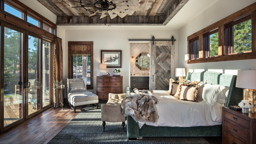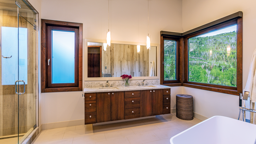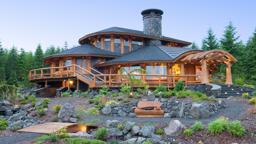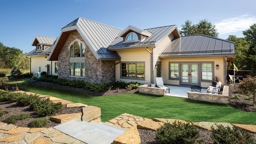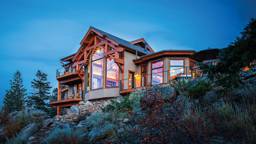These days, we’re all looking for ways to shave expenses without sacrificing quality. Things like clipping coupons or combining errands to save on gas are no-brainers, but when you’re in the throes of planning your forever home, the path to savings may not be quite as clear.
One solution not only helps to cut down on expenses, it also reduces square footage AND brings people closer together. Enter: the family bath.
We know, we know … one bathroom? For the whole family? It’s madness, right? Not with the right approach (aka, the right layout).
Family baths are workhorses designed to stand up to heavy use, so you’ll need to employ a little creative planning and clever design ideas to develop a bath that not only accommodates the entire family but is attractive and luxurious to boot. Here’s how.
Modernize the Design
Once a simple rectangle barely large enough to accommodate a tub, sink and toilet, baths (especially ones designed for an entire family) have morphed into suites with separate spaces designated for specific purposes, whether it’s using the commode, showering or brushing teeth. Reconfiguring the footprint and increasing the size of the bathroom will help to accommodate more people and allow you to create a more functional floor plan in the allotted space.
While dual sinks have become the norm, don’t feel you have to stop there. If you have the space, the budget and, most importantly, the need for more,
go for it! If space is at a premium, a custom trough sink, with multiple faucets, may fit the bill.
Also, don’t neglect access. If the bathroom will lie between two bedrooms, connect them with doorway to each (for that en-suite feel), as well as an entry point from the hallway. This way, non-overnight house guests won’t have to enter the bathroom via a bedroom.
Get in the Zone
Much like the old-fashioned kitchen-triangle concept has retreated to make way for a more task-oriented “zone” approach, the family bathroom can adopt a similar design philosophy.
Split the space into multiple compartments to establish a sense of privacy. A popular layout prominently places a double vanity or two sinks and a large soaking tub in the center of the floor plan. You can even plan for two water closets and two stand-up showers so that several people can use the room simultaneously.
Factor in the Future
Universal design is not just for people with mobility challenges or even for aging in place – it’s for everybody. If a shared bathroom will be used by multiple generations of family and guests, plan for the unknown by incorporating features like:
- Curbless (no raised threshold) showers
- Floating vanities (able to be accessed from a chair/wheelchair)
- Lowered sinks
- Raised commodes (16 inches high)
- Non-slip flooring
- Strong, bright lighting
- Decorative but functional grab bars
These features will allow everyone from small children to great-grandparents to use the facilities safely. And, in the case of a forever home, they’ll provide you a little extra insurance as you and your home age gracefully together.
Shower the Shower with Attention
When you’re sharing a bathroom with multiple people, a soak in the tub is going to be a once-in-a-while luxury, so focus your efforts more on the shower. Customize the layout so there’s enough room for two. (This is especially helpful in situations where kids will be getting clean at the same time.)
Install multiple showerheads, body sprays, steam nozzles and hand-held showers to create a spa-like environment. To keep shampoo, soap and shave cream organized, you can even go so far as to include an assigned shower-caddy for each family member.
Add Ample and Smart Storage
Storage is always an essential bathroom ingredient, but when you share it with your family and guests, it’s vital to have convenient and private spots to stow your stuff, as well designated areas where your visitors can keep their bath items on hand.
Medicine cabinets are bigger and deeper than they used to be, and dresser-style vanities often include specialized storage for toiletries and supplies. Drawer inserts intended to bring order to utensils and food in the kitchen are finding new purpose in bathroom organization. Large, furniture-style chests are great for storing towels, bottles, bulk supplies and grooming appliances.
Don’t Skimp on Space
To make sure your family bath functions well, plan a clear floor space of at least 30 inches from the front edge of all fixtures (sink, toilet, bidet, tub and shower) to any opposite bath fixture, wall or obstacle. For ample counter space, the distance between the centerlines of two vanity sinks should be at least 36 inches.
Also, keep in mind that standard doors that swing open into a room are complete space hogs, so in bathrooms where you’re trying to incorporate a lot fixtures and surfaces into a small footprint, install pocket or sliding barn-style doors that lie flush with the wall.
And Don’t Forget the Charm
Just because you’re trying to create a functional family bathroom doesn’t mean you have to leave out the details that personalize a space. Highlight exquisite elements (think: elegant timber posts and beams, rustic log wainscoting or full-log walls, textural poplar-bark trim — even wallpaper), and install your bathroom’s basics in areas that will show off its artistic features to their best advantage.
Instead of buying basic cabinetry, seek out antique dressers to convert to sink vanities, or add a hutch in lieu of a built-in linen closet.
These are the kinds of personalized details that turn a workhorse, like a family bath, into a soothing, special place that everyone will enjoy.









